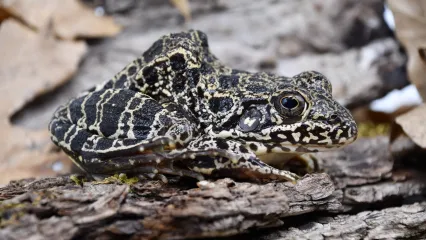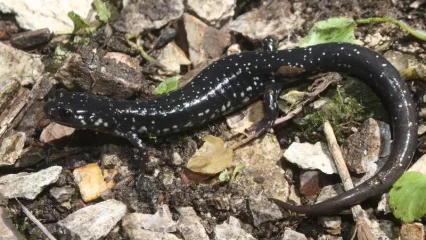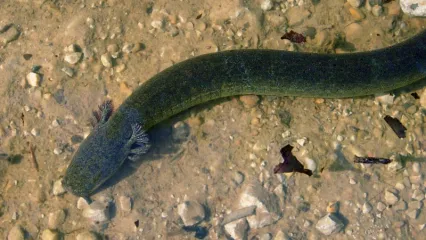
Description
Although the color of American toads vary from brown to gray, many individuals tend to be light to dark reddish-brown. In some individuals, small warts of the same color are evenly spaced over the back, whereas in others, a few warts are grouped in small dark spots. The belly is white to light yellow and may have some indistinct spotting. During the breeding season, males have a dark gray to black throat, whereas females have a white throat. The parotoid glands generally do not touch the cranial crests, although in some individuals, a small spur extends from the outer edge of the cranial crest to touch the parotid gland. Like other toads, the lower part of the belly has a pinkish area called the pelvic patch; the skin of the patch is more permeable to water than the skin on other parts of the body, allowing the toad to rehydrate by pressing the pelvic patch on damp soil.
Tadpoles are mostly black with golden flecking on the upper part of the tail. The fins are translucent, and the eye has a golden ring surrounding a black pupil.
The call of the American toad is a loud trill. In eastern Oklahoma the call lasts about 8 seconds, but in the central part of the state, the call is longer, lasting about 18 seconds.
Size
Male American toads are smaller than females. Males generally reach 1.5 to 2.5 inches in length, whereas females may reach 3.5 inches. When gravid in the spring, females are much heavier-bodied than males.
Habitat
The American toad is common throughout the eastern half of Oklahoma. Individuals are frequently encountered around houses or outbuildings, especially at night. These toads occur in eastern Oklahoma, Kansas, and in other states primarily to the north and east, as well as in southeastern Canada. It does not occur in most of the southern U.S.
Life Cycle
The American toad breeds earlier than other toads in Oklahoma. Its calls are typically heard beginning in mid-March, usually in association with spring rains. The breeding season extends from March to as late as June, depending on weather conditions, although the largest choruses occur in March and April. Choruses form in temporary ponds, flooded fields or ditches, and pools formed in slow-moving streams. Males attract females to the breeding site with their call. During amplexus, females deposit up to 8,000 eggs, which are laid in long gelatinous strands. Tadpoles hatch in 3-10 days, depending on temperature and metamorphosis occurs after 4-8 weeks in the tadpole stage. Newly metamorphosed toads are tiny, from a quarter to a half inch in length. After transformation into toadlets, they disperse widely, usually seeking damp areas where small insects are abundant, such as river or pond edges, gardens, or low, shady areas. Small toadlets are diurnal, in contrast to adults, which are nocturnal.
These toads typically eat insects and spiders.
How To Observe
These toads are commonly seen at night waiting for insects around street lights or porch lights in areas with suitable habitat. During the breeding season, American toad choruses can be located by following their loud trills to the breeding site. Toadlets and small juveniles can be found abroad during day in damp areas.
(This profile was created by Dr. Laurie Vitt as part of a partnership between the Wildlife Department and the Sam Noble Oklahoma Museum of Natural History. It was funded as part of a larger State Wildlife Grant to survey and inventory amphibians and reptiles of the Wildlife Management Areas of Oklahoma: T-35-P-1.)


